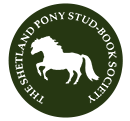Breed History
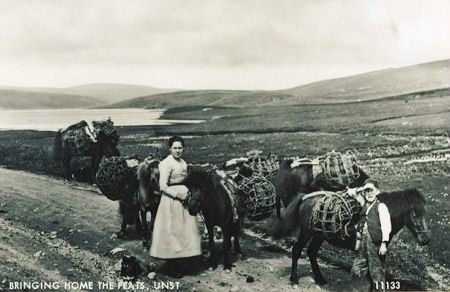 Small ponies have existed in the Shetland Isles for over 2000 years and probably much longer. Various excavations on the islands have revealed the bones of small ponies that existed during the Bronze Age and it is thought that ponies have been in domestic use there since this time.
Small ponies have existed in the Shetland Isles for over 2000 years and probably much longer. Various excavations on the islands have revealed the bones of small ponies that existed during the Bronze Age and it is thought that ponies have been in domestic use there since this time.
It is believed that the Shetland has its origin in the Cob type of Tundra and the Mountain Pony type from Southern Europe which migrated via the ice fields and land masses, with later introduction of a pony brought to the islands by the Celtic people which had evolved from crossing the same Mountain Pony type with the Oriental horse.
Owing to its island existence the pony has evolved with relatively few importations and those that did arrive were by necessity small owing to the difficulties of transportation by sea. Two significant types established themselves within the breed, the heavier boned animal with a longer head and the lighter one with high tail carriage and small pretty head, and these have remained distinct characteristics which has stood the pony in very good stead for its changing roles in the service of mankind.
Over the centuries various reports and descriptions of the pony refer to its small stature, strength, hardiness and longevity. The harsh winters of the Islands with little feed due not to the neglect of owners but to the difficulties of available fodder for even their sheep and cattle is surely the reason for the hardiness and purity of the breed, only the toughest surviving successive winters to breed. No place in Shetland is further than four miles from the sea and it is legendary that during the worst winters lack of grazing on the scathold would drive some ponies to forage for seaweed along the shores. The ponies however were not small due to sparse living conditions but rather it was the small pony that was able to survive this, whereas larger horses did not. Shetlands bred in milder climates which are given ample food do not increase in size at all.
Various stories about the ponies strength are legendary – for their size they are the strongest of all the horse breeds. For centuries the pony cultivated the land, carried the peat from the scatholds and seaweed for the fields, and was used to transport his owner. The pony was never a draught animal until the mid 19th century as there were no proper roads until then. The horse owning fisherman was able to use hair from the ponies tails for his lines.
When the law in 1847 banned children from entering the coal pits, the Shetland pony colts became in great demand and many had to exchange the freedom of the hills for the darkness of the mines. In fact their docile and willing nature enabled them to adapt very well to their underground environment and they were treated with much affection by their handlers and every so often they were returned to above ground for a period of time. At this time several studs were formed in an attempt to improve the stock by the use of the best stallions available that would breed ponies with the bone and substance necessary for the pit trade.
The breed also attracted much interest for children to ride and for driving and many people including Queen Victoria owned several pairs of Shetlands for drawing their smart phaetons. In the last twenty years of the nineteenth century thousands of ponies left the islands, reports of over one thousand a year, and many were exported across the Atlantic.
During this period of huge popularity the Shetland Pony Stud-Book Society was formed in 1890 with the aim of publishing a Stud-Book which was the first for a native breed of pony in Britain. Many of the registered ponies today can trace their pedigrees back to the first volumes of the Stud-Book and we owe much to the skill and dedication of the owners of these early studs in selecting the best ponies from the unregistered stock available to them. Most notable of these was the Marquis of Londonderrys stud which was formed in the 1870s on the islands of Bressay and Noss to supply ponies for the collieries he owned in County Durham. By careful selection of stock he produced a much improved animal in a remarkably short time and these ponies had the most significant effect on the type of ponies we have today. Ponies with the best conformation available were acquired and the stallions closely bred to, the most famous being Jack 16 who had 49 direct descendants out of the 58 mares entered in Volumes I and II of the Stud Book. The stud was dispersed in 1899 but most of the main breeders of this time acquired stock from this Stud including the Ladies Hope who brought ponies south to their home in Sussex where they bred with great success and the stud continues today. They kept only the best of their ponies for breeding and when certain the type was true they also bred close. They had the most Londonderry blood of any in their stock and many breeders acquired stock from them with the result that numerous ponies of today trace back to the Bressay stud through the Hope lines.
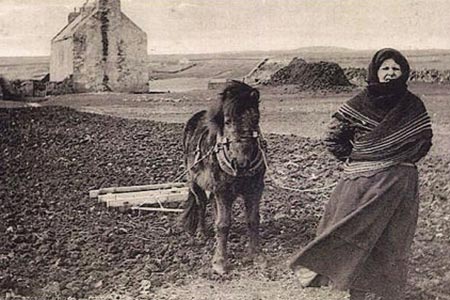
Woman ploughing
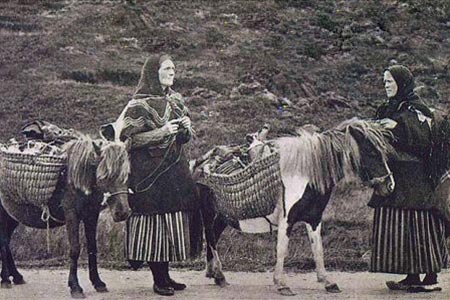
Shetland Market
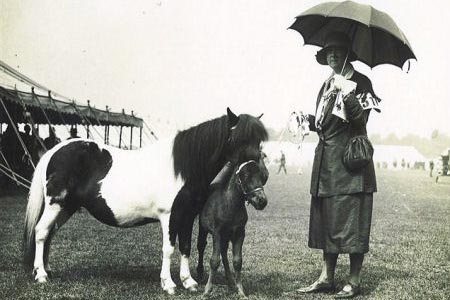
Pony Show
